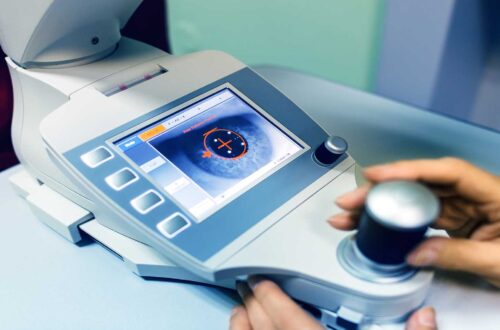
Managing Astigmatism through Customized Laser Eye Surgeries
Astigmatism is a common eye condition that affects the shape of the cornea, leading to blurred or distorted vision. Fortunately, advancements in technology have made it possible to treat astigmatism effectively through customized laser eye surgeries. In this article, we will explore the basics of astigmatism, the role of laser eye surgery in its management, the different types of surgeries available, and how to prepare for surgery and care for your eyes post-surgery.
Understanding Astigmatism
Astigmatism is a common refractive error that affects the way light enters the eye and is focused on the retina. It occurs when the cornea, the clear front surface of the eye, has an irregular shape. Instead of being perfectly spherical like a basketball, the cornea is shaped more like a football or rugby ball. This irregular curvature causes light to focus unevenly on the retina at the back of the eye, resulting in blurred or distorted vision.
Now, let’s delve deeper into the basics of astigmatism. There are two main types of astigmatism: regular and irregular. Regular astigmatism occurs when the cornea curves more in one direction than the other. This means that the cornea is shaped like a cylinder, with one meridian being steeper than the other. On the other hand, irregular astigmatism is caused by an uneven curvature of the cornea, often due to an injury or eye disease. In this case, the cornea is shaped in a more irregular and unpredictable manner.
In addition to the classification based on regularity, astigmatism can also be categorized as either corneal or lenticular. Corneal astigmatism refers to cases where the irregularity in shape is primarily due to the cornea, while lenticular astigmatism occurs when the lens inside the eye contributes to the astigmatic condition.
Causes and Symptoms of Astigmatism
Astigmatism can be present from birth or develop later in life. It is often hereditary, meaning that it can be passed down from parents to their children. In some cases, astigmatism may also be caused by eye injuries, eye surgeries, or certain eye conditions such as keratoconus.
Now, let’s talk about the symptoms of astigmatism. Common signs and symptoms of astigmatism include blurred or distorted vision at all distances. This means that both near and far objects may appear blurry or out of focus. People with astigmatism may also experience eye strain, especially after prolonged periods of reading or using digital devices. Headaches can also be a common complaint, as the eyes work harder to compensate for the irregular curvature of the cornea. Additionally, individuals with astigmatism may find it more challenging to see clearly at night, as the uneven focusing of light can cause increased glare and difficulty with low-light conditions.
In conclusion, astigmatism is a refractive error that occurs when the cornea has an irregular shape. It can be classified as regular or irregular, and corneal or lenticular, depending on the nature of the irregularity. Astigmatism can be present from birth or develop later in life, and it is often hereditary. If you experience any of the symptoms mentioned, it is important to schedule an eye examination with an optometrist or ophthalmologist to determine the best course of action for your vision needs.

The Role of laser eye surgery Sydney in Astigmatism Management
laser eye surgery Sydney offers a safe and effective solution for managing astigmatism. By reshaping the cornea using laser technology, the surgeon can correct the irregular curvature and improve vision quality. This surgical procedure can significantly reduce or even eliminate the need for glasses or contact lenses.
Astigmatism is a common refractive error that occurs when the cornea or lens of the eye has an irregular shape. This irregularity causes light to focus on multiple points instead of a single point on the retina, resulting in blurred or distorted vision. Laser eye surgery, such as LASIK or PRK, provides a precise and targeted approach to correcting this condition.
How Laser Eye Surgery Works
Laser eye surgery, such as LASIK (Laser-Assisted In Situ Keratomileusis) or PRK (Photorefractive Keratectomy), begins with an initial consultation and comprehensive eye examination to assess your overall eye health and determine your eligibility for surgery. During the procedure, a laser is used to remove a thin layer of corneal tissue, allowing the cornea to be reshaped and light to focus properly on the retina. The surgery itself usually takes only a few minutes per eye and is virtually painless.
Before the surgery, the surgeon will use advanced diagnostic tools to map the unique curvature of your cornea. This detailed mapping allows for a customized treatment plan that addresses your specific astigmatism. The surgeon will then create a thin, hinged flap on the cornea using a microkeratome or femtosecond laser. This flap is gently lifted, and the underlying corneal tissue is reshaped using an excimer laser. The laser precisely removes tissue according to the predetermined treatment plan, correcting the irregular curvature and improving vision.
Once the cornea has been reshaped, the surgeon carefully repositions the corneal flap, which adheres naturally without the need for stitches. The flap acts as a natural bandage, protecting the treated area and promoting faster healing. The entire procedure is performed under the guidance of computer-controlled precision, ensuring accuracy and safety.
Benefits of Laser Eye Surgery for Astigmatism
Laser eye surgery offers several benefits for people with astigmatism. First and foremost, it provides enhanced vision clarity and reduces or eliminates the reliance on corrective eyewear. The precise reshaping of the cornea allows light to focus properly on the retina, resulting in improved visual acuity and sharper vision.
In addition to improved vision, laser eye surgery offers a quick recovery time. Most patients experience significant improvement in their vision within the first 24 to 48 hours after surgery. While some temporary side effects, such as dryness, glare, or halos around lights, may occur during the initial healing period, they typically resolve within a few weeks.
Furthermore, customized laser eye surgeries can be tailored to the unique needs and visual requirements of each individual patient. The surgeon takes into account factors such as the severity of astigmatism, corneal thickness, and overall eye health to create a personalized treatment plan. This customization ensures optimal results and patient satisfaction.
It is important to note that while laser eye surgery is highly effective in treating astigmatism, not everyone is a suitable candidate. Factors such as age, overall eye health, and the stability of your prescription will be evaluated during the initial consultation to determine eligibility for surgery.
In conclusion, laser eye surgery has revolutionized the management of astigmatism. With its precise and personalized approach, this surgical procedure offers enhanced vision clarity, reduced reliance on corrective eyewear, and a quick recovery time. If you are considering laser eye surgery for astigmatism, it is essential to consult with an experienced eye surgeon who can assess your eligibility and guide you through the process. Click here to read about LASIK Care and Recovery: Essential Tips for a Smooth and Successful Healing Process.
Types of Customized Laser Eye Surgeries for Astigmatism
When it comes to correcting astigmatism, there are two primary types of laser eye surgeries that are commonly used: LASIK and PRK. Both procedures have proven to be effective in improving vision and providing relief from the symptoms of astigmatism.
LASIK for Astigmatism
LASIK, or Laser-Assisted In Situ Keratomileusis, is one of the most popular laser eye surgeries for correcting astigmatism. This procedure involves a precise and meticulous process that aims to reshape the cornea, ultimately correcting the astigmatism and improving visual acuity.
During a LASIK procedure, the surgeon creates a thin corneal flap using either a microkeratome or a femtosecond laser. This flap is carefully lifted, exposing the underlying corneal tissue. The surgeon then uses an excimer laser to reshape the cornea, precisely removing tissue to correct the astigmatism. The amount of tissue removed is determined by the individual’s specific prescription.
Once the cornea has been reshaped, the surgeon gently repositions the corneal flap back into its original position. The natural adhesion of the corneal tissue helps to hold the flap in place, eliminating the need for stitches. Over time, the cornea naturally heals, and the patient experiences improved vision and reduced astigmatism.
PRK for Astigmatism
PRK, or Photorefractive Keratectomy, is another effective laser eye surgery option for astigmatism. This procedure differs from LASIK in the way the cornea is prepared for the laser treatment.
During a PRK procedure, the surgeon removes the thin outer layer of the cornea, called the epithelium. This is done to expose the underlying corneal tissue, which will be reshaped to correct the astigmatism. The removal of the epithelium allows the surgeon to directly apply the excimer laser to the cornea, ensuring precise and accurate corrections.
After the cornea has been reshaped using the excimer laser, a special contact lens is placed on the eye to protect it during the initial healing phase. Over time, the epithelium regenerates, covering the treated area and aiding in the healing process. As the cornea heals, the patient’s vision gradually improves, and the astigmatism is corrected.
PRK is often recommended for individuals with thinner corneas or those who may not be suitable candidates for LASIK. Although the recovery period may be slightly longer compared to LASIK, PRK can provide excellent results in correcting astigmatism and improving visual acuity.
Both LASIK and PRK have proven to be effective in treating astigmatism, and the choice between the two procedures often depends on the individual’s specific needs and preferences. It is important to consult with an experienced eye surgeon to determine the most suitable option for correcting astigmatism and achieving optimal visual outcomes.
Preparing for Laser Eye Surgery
Preparing for laser eye surgery is an essential part of the process to ensure a successful outcome.
Initial Consultation and Eye Examination
The first step is to schedule an initial consultation with an experienced eye surgeon. During this visit, a comprehensive eye examination will be conducted to determine your eligibility for surgery. The surgeon will assess your visual acuity, evaluate your corneal shape and thickness, and discuss your medical history and any medications you are currently taking. Be sure to ask any questions you have and disclose any pertinent information about your eyes.
Pre-Surgery Guidelines
Prior to your surgery, you will receive specific guidelines from your surgeon to follow. These may include stopping the use of contact lenses for a certain period before the surgery, avoiding makeup and perfumes on the day of the procedure, and arranging for transportation to and from the surgical center. It is crucial to adhere to these guidelines to ensure the best possible outcome.
Post-Surgery Care and Recovery
After laser eye surgery, proper care and adherence to post-operative instructions are vital for a smooth recovery.
What to Expect After Surgery
Immediately after laser eye surgery, your vision may be slightly blurry or hazy, and you may experience mild discomfort or a gritty sensation in your eyes. These symptoms are temporary and usually subside within a few days. It is important to avoid rubbing your eyes, swimming, or engaging in strenuous activities that may increase the risk of complications during the initial healing period.
Tips for a Smooth Recovery
To promote healing and ensure a smooth recovery, follow these tips:
- Use prescribed eye drops as directed by your surgeon to minimize dryness and prevent infection.
- Wear protective eyewear, such as sunglasses, in bright or dusty environments.
- Avoid strenuous exercises or activities that may strain your eyes for a few weeks post-surgery.
- Attend all scheduled follow-up visits with your surgeon to monitor your progress.
By following these guidelines and taking proper care of your eyes, you can maximize the benefits of laser eye surgery for astigmatism and enjoy clear, crisp vision for years to come.




